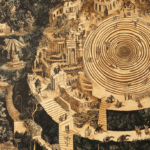
Ever felt like you’re running in circles in life? Welcome to the world of mazes—where getting lost isn’t a mistake, it’s the whole point.
From ancient mythical labyrinths to sprawling modern hedge puzzles, mazes have fascinated humanity for thousands of years. These structures represent more than their recreational purpose on Sundays because they symbolize both mystery and spiritual experiences as well as power and peace, and occasionally artistic masterpieces. This article explores the world’s most astonishing mazes, which unite historical significance with design excellence and human intellectual curiosity.
So lace up your walking shoes and bring your sense of direction—or don’t. We’re about to get deliciously lost.
Ancient Roots: Where Mazes Began
The Labyrinth of Knossos – A Myth That Still Twists Minds

Long before hedge mazes dotted royal gardens or corn mazes popped up every Halloween, there was Knossos, the mythical labyrinth of ancient Crete. According to Greek mythology, King Minos commissioned the master craftsman Daedalus to build an inescapable maze to imprison the fearsome Minotaur.
Whether or not the Minotaur ever really roamed that labyrinth, one thing’s for sure—the story stuck. And so did the idea of the labyrinth as a metaphor: a journey inward, a battle of wits, and sometimes, a fight for survival.
Egypt’s Lost Maze: The Labyrinth of Hawara

Did you know Herodotus once claimed to have seen a labyrinth in Egypt even greater than the pyramids? The Egyptian Labyrinth near Lake Moeris, built by Pharaoh Amenemhat III, is believed to have been a massive administrative and religious center. Though little of it remains, ancient texts speak of thousands of chambers, both above and below ground. Mysterious, right?
Roman & Etruscan Labyrinth Art

As the idea of labyrinths spread across the ancient world, the Romans and Etruscans adopted them too, not as traps, but as spiritual symbols. Their mosaics often featured single-path labyrinths, not meant to confuse, but to guide meditators toward spiritual enlightenment.
Medieval & Renaissance Marvels
Chartres Cathedral: The Pilgrim’s Labyrinth

By the Middle Ages, labyrinths took on a new form—spiritual pathways. Perhaps the most famous example? The labyrinth embedded in the floor of Chartres Cathedral in France. Pilgrims would follow the winding path as a symbolic journey to Jerusalem. No Minotaurs here—just inner reflection.
This wasn’t about being lost. It was about finding yourself.
Garden Mazes of the Aristocracy
Fast forward to the Renaissance, and mazes got a serious makeover. Now they were tools of entertainment, status, and intellectual challenge. Aristocrats across Europe started planting elaborate hedge mazes in their gardens—perfect for a midday flirt or a leisurely mind game.
One standout is the Hampton Court Maze in England, commissioned by King William III in the late 1600s. It’s still open to the public today, so yes, you can literally get lost like royalty.
The Biggest and Boldest Mazes on Earth
Dole Plantation Maze, Hawaii – A Fruitful Puzzle

Set on the lush grounds of a pineapple plantation, the Dole Plantation Maze once held the title of the world’s largest maze. With over 14,000 colorful Hawaiian plants, it’s more than a walk—it’s a full-on tropical adventure.
Don’t be fooled by its friendly look. With nearly 2.5 miles of paths, it’s easy to lose track of time—and direction.
Longleat Maze, England – The Most Twisting Maze in the UK
Imagine 16,000 English yews, meticulously trimmed into a living puzzle. That’s Longleat Maze for you, part of the grand Longleat Estate. But here’s the twist—it’s three-dimensional. Wooden bridges, viewing towers, dead ends galore—it’s like a maze within a maze. Visitors often underestimate it… and then spend hours trying to find their way out.
Peace Maze, Northern Ireland – A Path Toward Unity
More than just hedges, the Peace Maze in County Down represents something deeper. Built with the help of thousands of schoolchildren during the Northern Ireland peace process, it’s a living symbol of reconciliation. Walk it, and you’re literally tracing the steps from conflict to harmony.
Andrássy Castle Maze, Hungary – A Gothic Garden Labyrinth
The Andrássy Castle Maze combines elements of gothic fantasy with botanical artistry within a Hungarian historical estate. The maze’s hedges create a romantic European atmosphere that combines with old-world mystique to attract both history enthusiasts and hopeless romantics.
The Meaning Behind the Maze
A Metaphor for Life

Let’s get a little poetic for a moment. A maze isn’t just about turns and dead ends—it’s a mirror for life itself. You walk, you wonder, you backtrack. You lose your way, then stumble back onto the path. Sound familiar?
Mazes serve as psychological metaphors to represent decision-making processes and self-discovery in psychological studies. Stories use mazes to represent transformation through the examples of Theseus defeating the Minotaur and the movie hero who navigates endless corridors to discover truth.
Rituals, Religion, and Reflection
Labyrinths are still used today for spiritual practice. In many Christian churches, followers walk labyrinths in quiet contemplation. In yoga and mindfulness circles, labyrinth walks are used as walking meditations, where each step is a breath, and every turn is a lesson.
Behind the Scenes: How Mazes Are Made
Designing a Maze – More Than Just Random Turns
Creating a great maze is like composing a symphony—there’s rhythm, suspense, and even a bit of mischief. Designers often use mathematical algorithms and symmetry patterns to plan out mazes that challenge and surprise.
But it’s not just about logic—it’s about experience. A great maze makes you feel something. Awe. Frustration. Joy when you finally find the exit.
Tech Meets Tradition
Today, mazes have gone digital. Some mazes use augmented reality (AR) to enhance the journey. Others integrate interactive stations, puzzles, and even smartphone apps to guide (or misguide) you along the way.
And let’s not forget how drones are now helping designers see the whole layout from above. Talk about bird’s eye planning!
Mazes in Pop Culture
From Harry Potter to Horror

Mazes have always made great set pieces in movies and books. Think of the terrifying maze in The Shining, or the magical one in Harry Potter and the Goblet of Fire. Or the entire premise of The Maze Runner—a dystopian twist on an ancient concept.
Why do we love them so much in fiction? Because they’re the ultimate narrative device. They trap our heroes. Test their courage. Force them to grow.
Puzzle Games and Virtual Mazes
Mazes aren’t just on the big screen—they’re on our screens, too. From retro arcade games to modern puzzle apps, digital mazes feed our need for challenge and adventure. And let’s be honest—who hasn’t yelled at their phone while stuck in a maze game?
The Modern Maze Experience
Maze Tourism – It’s a Thing!
Yes, maze tourism is real. Around the world, people plan entire vacations around visiting famous mazes. From corn mazes in the American Midwest to lavender labyrinths in France, there’s a whole industry dedicated to walking in circles—on purpose.
Some are themed. Some are spooky. Some are sweet. But all of them are unforgettable.
Green and Growing – Eco-Friendly Mazes
Modern maze makers are also thinking about sustainability. Many now use native plants, solar lighting, and natural irrigation systems. It’s not just about getting lost anymore—it’s about doing it responsibly.
Conclusion: Why We Love Getting Lost
Mazes have been with us since ancient times, winding through our myths, gardens, temples, and even our screens. They reflect our deepest questions, challenge our minds, and invite us to get lost—not in fear, but in fascination.
And maybe that’s the whole point.
In a world that demands constant clarity and direction, mazes remind us that it’s okay to wander. It’s okay to take the wrong path, double back, and try again. Because sometimes, the journey is the destination.
So go ahead. Step inside. Take that turn. Lose yourself… and see what you find.
Read More – Odd Jobs You’ve Never Heard Of: From Professional Cuddlers to Dog Surfing Instructors










